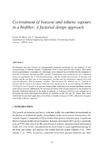Co-treatment of benzene and toluene vapours in a biofilter: A factorial design approach

View/
Use this link to cite
http://hdl.handle.net/2183/12844Collections
Metadata
Show full item recordTitle
Co-treatment of benzene and toluene vapours in a biofilter: A factorial design approachDate
2007Citation
Biotechniques for Air Pollution Control II, 2007: 133-142. ISBN: 978-84-9749-258-4
Abstract
[Abstract] Biofiltration has now become an indispensable treatment technique for the removal of low concentrations of Volatile Organic Compounds (VOCs) from process vent streams. This study involves performance evaluation of a laboratory scale compost based biofilter for the treatment of mixtures of benzene and toluene (BT) vapours. Experiments were conducted as per a statistical design of experiment, the 2k full factorial design, with the initial concentrations of benzene and toluene and the gas flow rate as the independent variables and the elimination capacity (EC) and removal efficiency (RE) as response variables. The maximum EC attained was 31.7 g/m3.h for benzene and 85.9 g/m3.h for toluene, while the total maximum EC at an inlet loading rate (ILR) of 150.2 g/m3.h was 91.2 g/m3.h. It was also observed that while there was mutual inhibition, benzene removal was severely inhibited by the presence of toluene than toluene removal by the presence of benzene. Statistical analysis in the form of analysis of variance (ANOVA) was carried out to determine the main and interaction effects of variables on the RE and EC values. This study establishes the potential application of biofilters to handle mixtures of VOCs effectively through a statistically authentic approach.
ISBN
978-84-9749-258-4





